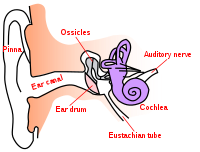
Photo from wikipedia
Objectives: Infection-related childhood hearing loss is one of the few preventable chronic health conditions that can affect a child’s lifelong trajectory. This study sought to quantify relationships between infection-mediated hearing… Click to show full abstract
Objectives: Infection-related childhood hearing loss is one of the few preventable chronic health conditions that can affect a child’s lifelong trajectory. This study sought to quantify relationships between infection-mediated hearing loss and middle ear disease and environmental factors, such as exposure to wood smoke, cigarette smoke, household crowding, and lack of access to plumbed (running) water, in a northwest region of rural Alaska. Design: This study is a cross-sectional analysis to estimate environmental factors of infection-related hearing loss in children aged 3 to 21 years. School hearing screenings were performed as part of two cluster randomized trials in rural Alaska over two academic years (2017–2018 and 2018–2019). The first available screening for each child was used for this analysis. Sociodemographic questionnaires were completed by parents/guardians upon entry into the study. Multivariable regression was performed to estimate prevalence differences and prevalence ratios (PR). A priori knowledge about the prevalence of middle ear disease and the difficulty inherent in obtaining objective hearing loss data in younger children led to analysis of children by age (3 to 6 years versus 7 years and older) and a separate multiple imputation sensitivity analysis for pure-tone average (PTA)-based infection-related hearing loss measures. Results: A total of 1634 children participated. Hearing loss was present in 11.1% of children sampled based on otoacoustic emission as the primary indicator of hearing loss and was not associated with exposure to cigarette smoke (PR = 1.07; 95% confidence interval [CI], 0.48 to 2.38), use of a wood-burning stove (PR = 0.85; 95% CI, 0.55 to 1.32), number of persons living in the household (PR = 1.06; 95% CI, 0.97 to 1.16), or lack of access to running water (PR = 1.38; 95% CI, 0.80 to 2.39). Using PTA as a secondary indicator of hearing loss also showed no association with environmental factors. Middle ear disease was present in 17.4% of children. There was a higher prevalence of middle ear disease in homes without running water versus those with access to running water (PR = 1.53; 95% CI, 1.03 to 2.27). There was little evidence to support any cumulative effects of environmental factors. Heterogeneity of effect models by age found sample prevalence of hearing loss higher for children aged 3 to 6 years (12.2%; 95% CI, 9.3 to 15.7) compared to children 7 years and older (10.6%; 95% CI, 8.9 to 2.6), as well as for sample prevalence of middle ear disease (22.7%; 95% CI, 18.9 to 26.9 and 15.3%; 95% CI, 13.3 to 17.5, respectively). Conclusions: Lack of access to running water in the home was associated with increased prevalence of middle ear disease in this rural, Alaska Native population, particularly among younger children (aged 3 to 6 years). There was little evidence in this study that cigarette smoke, wood-burning stoves, and greater numbers of persons in the household were associated with infection-mediated hearing loss or middle ear disease. Future research with larger sample sizes and more sensitive measures of environmental exposure is necessary to further evaluate these relationships. Children who live in homes without access to running water may benefit from earlier and more frequent hearing health visits.
Journal Title: Ear and Hearing
Year Published: 2022
Link to full text (if available)
Share on Social Media: Sign Up to like & get
recommendations!